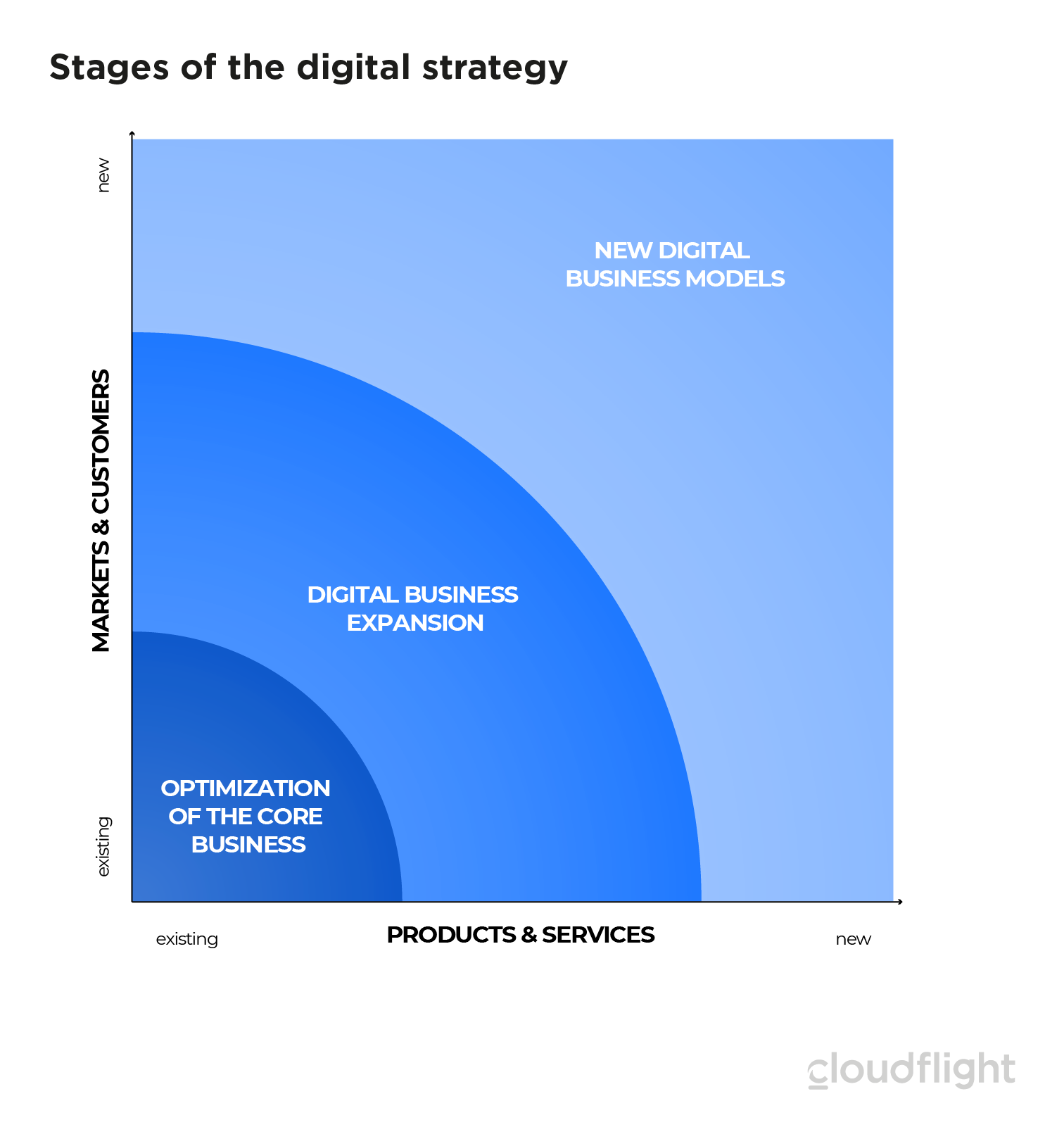The digital strategy is still understood very differently in many companies -perhaps because there is no concrete definition and everyone understands it differently. Is it the digitization of analog processes or the development of digital business models? The answer is “both” – both statements are correct. A fully comprehensive digital strategy includes all of these points.
Based on the “Innovation Ambition Matrix” by Nagji and Tuff, we have shown the different stages of digital transformation:
- Optimization of the core business
- Digital business expansion
- New digital business models

Optimization of the core business
As a rule, the first step in implementing a company’s digital strategy is to optimize its core business. The familiar business model remains the same – there are changes in the process flows and the organization. Process steps are simplified, accelerated or automated with the use of software. A great many companies are still in this stage or are starting to do so. Accompanying documents or papers in production are replaced by their digital counterparts, data is automatically transferred to the adjacent processes and document and data management is standardized.
These are just a few examples of what companies are doing in this phase of digitization. The activities serve to reduce costs throughout the entire organization and possibly raise industrial production to the next level – this approach is also known under Industry 4.0. However, optimized production does not mean more sales but “only” lower costs. There is no thinking further than “lean management in the digital era“.
However, in order to open up new sources of income, much more thought should be given to this. Digitization can be used in two further stages in your company, both of which promise more revenue from digital products, services or platforms:
- Digital business expansion
- New digital business models
In the following we will take a look at the ways of thinking, concepts and examples.
Digital business expansion
The first step, when it comes to digital business models, is usually the business expansion through digital components of an existing offering. Distribution channels are digitized or physical products are given a digital added value by means of IoT.
One example is the introduction of an online store. This changes the distribution channel, but not the business model per se: A shoe salesperson sells shoes, whether online or in stores. However, through digital expansion, he can tap into new customer groups or increase his reach.
How IoT was used as an extension is shown by the example of the “Smart Connect” service of the ÖAMTC. In addition to its annual membership, the ÖAMTC offers this additional service, which enables the customer to call up the current condition of his or her vehicle. Any problems that occur can be directly forwarded to the driver and the automobile club, so that the driver is proactively warned here before the vehicle breaks down. This service is billed via a monthly flat rate, which provides the automobile club with additional income. In addition, a solution like this also functions as a good marketing instrument.
Another example of digital business expansion is shown by the Kion Group with its latest generation of Linde Material Handling forklifts. Once the forklift has been purchased, additional services can be added, which were only made possible by the realization of the forklift’s digital twin. A weighing function in the fork or the shovel operation are only two options that are offered.
Although these examples are already very innovative for many companies, the solutions are still very close to the original business model. The next step is to develop fundamentally new digital business models.
New digital business models
However, business expansion alone is not enough to bring about radical changes. If you stay in this sector, the potential for innovation is only limited as you are still too close to the core business in your mind. For extraordinary innovations it is necessary to look for new sources of revenue outside the existing business model. You have to move into levels that you have not thought of before, that did not seem possible before.
One option is to become a platform provider, like LANXESS with CheMondis. The start-up is a spin-off from the chemicals group. The open platform is a marketplace that addresses the specific requirements of the chemical industry. Any company can offer chemicals here, not only the initiator LANXESS. This has created a completely new business model for the group, away from the regular business. The platform business model is often referred to as the “top of the line” because it is very complex overall to set up and operate a profitable platform. One of the biggest challenges is that you have to acquire sufficient users on both the supplier and the customer side so that the platform can develop its potential.
Another alternative is to change from a traditional service or product offering to a software manufacturer. If you look at the genesis of various SaaS (Software-as-a-Service) solutions, they often follow a similar pattern to Shopify: To set up an online store for snowboard equipment, the founders were not enthusiastic about any existing eCommerce solution. So they decided to develop their own software, from this basis Shopify was born. And it is exactly this thought that every company can play through: “Do we have a specially developed software that can provide added value for an entire industry?
Example: A specialized law firm has software written for its area of law in order to manage processes more efficiently and automatically. The clients also benefit from this, as the employees like to interact with it and the work is easier and more accurate. The “classic” law firm would maintain exactly this status quo and use the software at best as a marketing tool to attract new clients. A law firm that thinks in new business models would at least validate whether there is a market for a SaaS solution here. Potentially, there is a chance to earn money from any of the competing clients if you change from a pure law firm to a SaaS provider.
Create a basis for drawing conclusions for innovations
It is not without reason that we have cascaded the digital strategy into three stages in this article. As a rule, companies move through the digital transformation in exactly this order. Very few start directly with a new business model.
It is important to first create the basis and digitize basic processes in the company and collect data in a structured way. Only once you know your data, can you consider which digital business expansions or models are feasible.
Reflect again exactly where you stand or what you might have overlooked in your digital strategy. If you need a sparring partner for this, please contact us.
